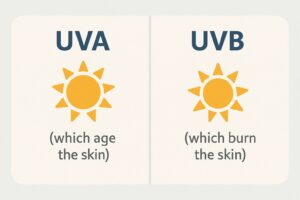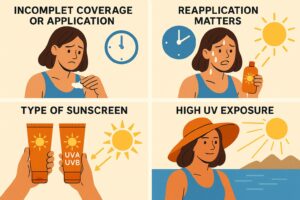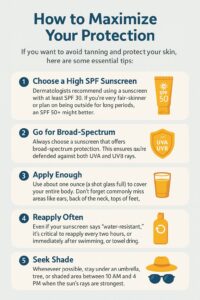Does Sunscreen Prevent Tanning? Here’s the Truth
Sunscreen is the most important item to have on hand when summer approaches if you’re planning a beach vacation. In order to shield their skin from sunburn, early aging, and even skin cancer, most individuals grab for it. One topic, nevertheless, frequently causes misunderstandings: Does sunscreen stop tanning?
The short answer: Not entirely.
Let’s examine the actual science underlying tanning, sunscreen, and the best ways to protect your skin.
What Exactly Happens When You Tan?
Your skin’s natural defense against UV (ultraviolet) rays is tanning. UV rays cause melanocytes, or skin cells, to generate more melanin, the pigment that gives your skin its color, when they penetrate your skin. Darker skin results from more melanin.
A tan is your skin’s SOS signal, to put it simply. It’s your body telling you, “Hey, we’re being attacked. Let’s put up a defense!”
It’s crucial to understand that, despite its lovely appearance, every tan is an indication of skin harm. Without some underlying damage to skin cells, there can never be a fully “healthy” natural tan.
How Does Sunscreen Work?
Sunscreens work by absorbing, reflecting, or dispersing UV radiation to protect your skin. Two categories of UV radiation are their primary targets:

• UVA rays (which age the skin)
• UVB rays (which burn the skin)
When you apply sunscreen properly, it creates a protective layer that reduces the amount of UV radiation that penetrates your skin. The SPF (Sun Protection Factor) rating on your sunscreen tells you how much longer it would take for UVB rays to redden your skin compared to bare skin.
For instance, an SPF 30 means it would take 30 times longer for your skin to start burning compared to without any protection.
So… Does Sunscreen Prevent Tanning?
Although it doesn’t usually completely stop it, sunscreen can significantly lessen tanning.
Here’s why:

1. Incomplete Coverage or Application
Many people don’t apply enough sunscreen or miss certain areas. According to dermatologists, most people only apply 25-50% of the recommended amount.
2. Reapplication Matters
Sweat, water, and time break down sunscreen. If you don’t reapply every two hours (or after swimming or sweating), your protection weakens.
3. Type of Sunscreen
Not all sunscreens are broad-spectrum. Broad-spectrum sunscreens protect against both UVA and UVB rays. If your sunscreen doesn’t shield you from UVA rays (which are more responsible for tanning), you might still tan even if you’re protected from burns.
4. High UV Exposure
In very strong sunlight (like near the equator or at high altitudes), even sunscreen can’t block 100% of rays. A small amount of UV still reaches your skin, triggering melanin production.
In short: Sunscreen reduces the intensity of UV exposure, which slows down and minimizes tanning, but if you spend enough time in the sun, some degree of tanning can still occur.
Is It Bad to Tan Even If I Use Sunscreen?
Unfortunately, yes.
Any darkening of the skin brought on by UV exposure indicates harm to your skin cells. Repeated UV damage over time may result in:
• Premature aging (wrinkles, sunspots)
• Loss of skin elasticity
• Hyperpigmentation
• Increased risk of skin cancers (including melanoma)
Even if you don’t burn, you’re still accumulating sun damage.
How to Maximize Your Protection

If you want to avoid tanning and protect your skin, here are some essential tips:
1. Choose a High SPF Sunscreen
Dermatologists recommend using a sunscreen with at least SPF 30. If you’re very fair-skinned or plan on being outside for long periods, an SPF 50+ might be better.
2. Go for Broad-Spectrum
Always choose a sunscreen that offers broad-spectrum protection. This ensures you’re defended against both UVA and UVB rays.
3. Apply Enough
Use about one ounce (a shot glass full) to cover your entire body. Don’t forget commonly missed areas like ears, back of the neck, tops of feet, and hands.
4. Reapply Often
Even if your sunscreen says “water-resistant,” it’s critical to reapply every two hours, or immediately after swimming, sweating, or towel drying.
5. Seek Shade
Whenever possible, stay under an umbrella, tree, or shaded area between 10 AM and 4 PM when the sun’s rays are strongest.
6. Wear Protective Clothing
Long-sleeved shirts, wide-brimmed hats, and UV-protective sunglasses can add an extra layer of defense.
What About Tanning Oils with SPF?
A “tanning oil with SPF 15” or anything like that is advertised in several brands.
Be wary:
SPF 15 is regarded as low protection and primarily guards against burning, not tanning or damaging skin over time. These products increase your risk of skin injury because they are made to promote tanning while providing little protection.
Can You Tan Safely at All?
Self-tanners, such as sunless tanning lotions, sprays, or mousses, are a far safer option if you want a sun-kissed hue without endangering the health of your skin. They temporarily darken your skin’s outermost layer without exposing you to dangerous UV radiation.
Just keep in mind that you still need to wear sunscreen outside even if you use a self-tanner! No UV protection is provided by a synthetic tan.
Final Thoughts
Sunscreen is your skin’s best ally against the sun’s damaging effects.
Although it significantly reduces the chance of sunburn and tanning, it is not a miracle cure. Even with sunscreen, prolonged contact to the sun can cause skin damage and trigger the creation of melanin.
It takes a multifaceted strategy to avoid tanning and preserve the health and youth of your skin: using sunscreen correctly, finding shade, dressing in protective apparel, and paying attention to the sun’s strength.
Bottom line?
Smart sun habits are essential since, while sunscreen greatly minimizes tanning, it cannot totally eliminate it.

This piece exudes a sense of calm certainty — the kind of writing that makes you feel grounded and at ease.